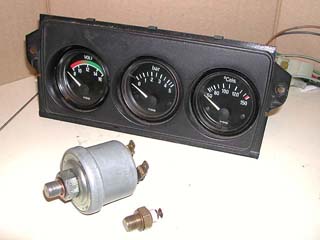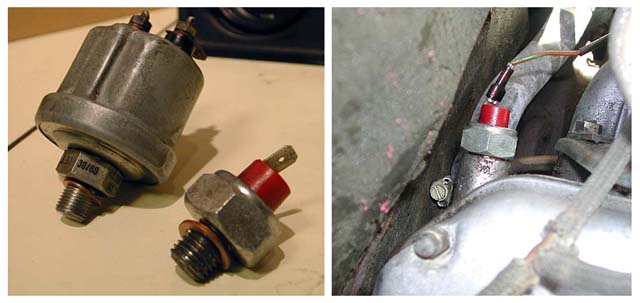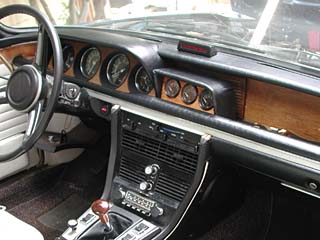
VW gauges with senders
by Devinder Grewal, 14 October 2001
I don't know why BMW feels the need to leave out an essential item like an oil pressure gauge, but they seem to have done this consistently on all of their mass produced cars. I started out looking for an oil pressure gauge for my coupe. As I went about figuring out how to install the sending unit and route the wiring, I realized that adding multiple gauges is no more difficult that a single gauge. I finally decided that I wanted a voltmeter for the electrical system, an oil pressure gauge (for obvious reasons), and an oil temperature gauge to figure out when the engine was really warmed up. This whole process was not nearly as difficult as I thought it would be. Simple machining skills are required although you may be able to get someone else to that for you.
GAUGE SELECTION
You can buy new VDO gauges if you want to but they are pricey and none of the current styles goes with the old VDO gauges already in the car. VDO (and others) will custom make ones with back face, chrome bezel, white needles, etc. but I don't even want to ask the price for this.
So, I went looking for "period" gauges that would look right. To match the stock gauges, I wanted at least VDO, black face, white needle, correct font, and metric units. Audi and VW both have gauges in them but the Audi ones are more integrated and have a horrible font, so I went with the VW gauges.

I don't know all the possible models that could have the right gauges but I found that the VW rabbit convertibles always have the correct set of three (volts, oil temp, oil pressure) and the red needles are almost always faded to white. These appear to be similar to the current VDO "cockpit" series with red needles.
The oil temp gauges I came across were all 150ºC so you can get any sender to work with these (even from a non-gauged VW). Most of the senders I've seen on VW's have an M10x1.0 straight thread and use an M10 crush washer, but older flat 4's in VW's and Porches use M10 pipe taper thread. If you have any doubts, read the wrench flats on it. It should say VDO, temperature range, part number, and manufacture date. You want a 150ºC sender to go with the 150ºC gauge.
For the oil pressure you have two choices, 5 bar or 10 bar. You will need to get the correct sender for each one. The 10 bar gauge and sender is very rare on VW's, but Porsche's have this setup (924, 944 I think). VW only lists the 5 bar unit in their parts catalogs. You can get a 10 bar sender/switch from VDO but it will have M10 pipe tape threads. The VW pressure senders have dual output; a switch to work the idiot light and a sender for the gauge. These are all M10x1.0 straight thread and you need a thin wrench to get at it (17mm, I think). This sender will also have markings on the wrench flats indicating, among other things, the pressure range and the switch opening pressure.


ADAPTING SENSORS AND WIRING
The old style bottom-bolt oil filter housing has a boss on the right side for a sensor. This boss is pre-drilled for an M12 coarse thread (you just needs to finish the hole and tap it). There a couple of options here: you can get a 1/4 NPT 150ºC temp sender from VDO and tap the hole for this or you can use the VW M10 sender. The best thing for the VW sender is to get a 1/4 NPT x 1/8 NPT brass bushing and tap the boss for this bushing. The 1/8 NPT threads are very close to M10x1.0 so you can chase the inside of the bushing with a tap and use the VW sender. One other option is to replace the oil pan drain plug with a sensor. These are available from VDO also. The oil pan is not the best place to measure temperature because there is minimal flow and the pan is cooled by airflow. The oil filter housing is a good place to measure oil temperature since all the oil going to the engine flows through there.

There is no boss on the newer top-bolt filter housings and the casting has thin walls everywhere. Because the walls are so thin a straight-thread can't seal well. I got around this problem by putting a bushing in the wall where the boss should be.

The pressure sending unit needs to be at the far end of the oil circuit so the head is a good location. The BMW pressure switch uses an M12x1.5 thread. Old head castings (at least through 74) use the lower boss at the rear of the head and the newer castings (like '77 on) use the upper boss. In both cases, there is not enough room between the firewall and intake manifold (or intake runners) to simply replace the pressure switch with the larger combination switch/sender. If you don't care about the idiot light, then an M12x1.5 pressure sender is available from VDO and it should be small enough to fit in there.
I decided to make an adapter that allows me to use the combination switch/sender so both the idiot light and the oil pressure work. The adapter is a 3/4" x 3/4" aluminum bar with a custom banjo bolt that relocates the VW sensor. Don't get a high-strength bolt for the banjo bolt because it will be very difficult to drill out. I used a grade-5 M12x1.5 x 35mm.



The backs of the gauges have 3 connections, except for the volt meter, which has only two. One is for ground (brown if you have part of the harness), one is for +12v (black) and the other one (multi-color) is for the sensor. The volt meter requires no wires from the engine compartment. I routed the two sensor wires from the engine through the firewall next to the A/C lines. +12v comes from the fuse box. Look for a circuit that is hot when the ignition is on. The dash illumination can be taken from the circuit the illuminates the HVAC controls.
GAUGE PLACEMENT
The console (where to A/C goes) is the best place for them, but if you have A/C then you need to be creative. I put mine in front of the dash speaker and made an enclosure that looks like the main instrument cluster. The black console shown in some of the pictures is out of an Audi (I forgot what year) and would work great where the A/C faceplate goes.

FUN WITH GAUGES
Voltage can tell you a few things. Excessively high voltage usually indicates a failed regulator. Low voltage can be due to low rpm, bad alternator, bad battery, bad grounds, excessive current draw from accessories, etc.
Oil temperature takes a while to get going so don't worry if there is no gauge movement at first. For me, it takes about a half-hour of city driving or about 15 minutes of freeway driving to reach the normal operating temperature of about 80ºC. It's important to know that the engine is not really "warmed-up" when the water temperature reaches the normal level.
There are two bypass valves in the oil system that can affect the pressure at the head. The bypass in the filter housing opens when the filter is clogged. The bypass in the oil pump opens at 4.5 bar and is intended to limit the system pressure. This valve is known to fail in these engines such that the pressure increases to 100+ psi and can blow the o-ring on the filter canister. When the oil is cold, it is possible to see pressures greater than 4.5 bar at higher RPM because the relief passage in the oil pump is not that big and limits the flow of cold oil. So, don't be worried if the needle is pegged on a 5 bar gauge when the oil is cold. (another reason to do the civilized thing and let the oil warm up before having fun with the car.) If the oil pressure gets above 5 bar after warm-up, then there may be a problem with the relief valve.
Anyway, this is about installing gauges so I'll leave the diagnostics for another time.
Devinder
-------------------------
conversion for Americans:
1.5 bar = 22 psi
5 bar = 74 psi
4.5 bar = 67 psi
10 bar = 147 psi
150ºC = 302ºF
NPT = National Pipe Taper